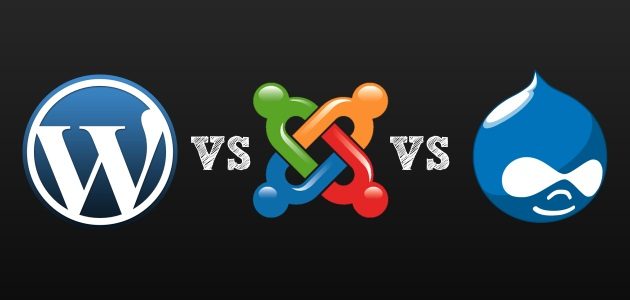Every IT person, developer, and programmer has an opinion when it comes to the various open source content management systems out there. It often comes down to functionality and ease of use, but even then the lines are often blurred and there is rarely a clear-cut victor. WordPress vs Drupal vs Joomla – which is really the king of open source CMS?
Our friends at Devious Media tackled the question and did a comprehensive breakdown, putting each CMS under a microscope to answer the most important questions to help people make a choice. For us, the choice is clear, but blogging is not the only thing important in the internet world. Other functionality traits need to be considered.
Click to enlarge.

(via: Canonsburg PA Mercedes)





38 User Comments
Robin Millette
Thank you for the infographic, although I could argue a few points, it’s a starting point.
Regarding monthly unique visitors to the main site, did you compare with wordpress.com or wordpress.org? Seems to me it was the former. Hope you can clear that up for us.
aditia
for me drupal is the hardest to learn compare to wordpress and joomla the last row describing it good
Sebastian Leitz
Nobody seems to know Contao 🙁
Derrick Knight
I found this chart to be an interesting compilation of information, but I am concerned that it is very easy to take many of the statistics out of context and therefore make an bad decision as to what platform to adopt for your specific needs. There are clearly strengths and weaknesses for each of these platforms making each of them ideal for specific site requirements.
When making a platform decision, shouldn’t site developers be examining the requirements of the site first? For example, if a site had a requirement for a single author informational site with only self contained information, then WordPress would be the least expensive solution (from all of the metrics identified above). However, if a site required multiple authorship of content, document approval processes/workflow and external data sources, then WordPress would quickly become a likely non-starter and potentially far more expensive to even attempt to implement where much of that functionality already exists in Drupal and Joomla!.
Of the metrics that were provided, it leaves the reader with the impression that like characteristics were being compared. For example the average setup/customization costs have no explanation. The fact is that sites with complex requirements will require higher setup/implementation costs, regardless of what platform you are using. If I try and push the complexity limits of WordPress, I assure you that you can have implementation costs that approach or exceed those in Drupal where the foundation for those features are already provided in the base platform, with a more stable environment as you don’t need to do many “tricks” to layer features that are not integral into the core architecture.
It would have been nice to have a category that describes general strengths of each platform to better guide the initial platform decision process.
Again, I think this is a great starting point, but do not believe it achieves the objectives outlined in the beginning of the article.
So, what would be useful for a client who is trying to figure out where to begin on the platform and partner to engage in for their project?
1) Put together an internal team to define requirements composed of someone representing your target customers, your marketing team and your IT organization.
2) Define specific, prioritized project requirements (not just layout, but sources of content, who will own and approve content)
3) When interviewing companies, look for reference clients who have similar requirements to yours and TALK TO THOSE REFERENCES. Ask what worked and what could be improved upon. Ask lots of questions about functionality that they could or couldn’t implement and why. If a company being interviewed starts telling you about limitations of the platform, move on to the next company. They may be stretching their “favorite” platform outside of the capabilities it was designed for.
4) Establish regular (weekly or more frequently) meetings to gain updates. Be flexible on the agenda, but have key metrics that are updated at every meeting to ensure that progress is being made.
-Derrick
Alec Kinnear
Derrick: WordPress has an issue with multiple authors?
What are you talking about? We’ve run sites with dozens of authors on WordPress with no issues. Yes, there is an approval process which works out of the box.
No development costs are much lower on WordPress as there are a core set of plugins which work out of the box and are completely cross-compatible so all you need to code are bridges and tweaks in most cases.
Example:
WordPress custom site with recipes and additional image posting and advanced community features: $3500 for CSS and programming.
Same site in Drupal, CSS and programming: likely around $10K and much longer development period.
Both estimates leave out the visual designer and site architect who costs $4 or $5 in both cases.
Ongoing maintenance costs are much lower on WordPress.
I can buy the argument on a really high end ultra custom site in the $50K and up category. Even then you’d get better value for your money in WordPress.
Someone replaced a WordPress WPMU network we were running with a Drupal network. Our WordPress network had about $30K of development in and maintenance costs of about $1000/month. The Drupal replacement cost $1,000,000 up front and had about $15K of maintenance/ongoing development costs per month. This particular client could afford to do things less efficiently but most can’t. The users still complain about Drupal in comparison to WordPress.
We had our own go at WordPress vs Drupal vs Joomla. It’s more fun crossing swords with Drupal as at least it’s a relatively close contest.
Derrick Knight
Alec,
With respect to the multiple authors, you are correct, I should have been more specific as I meant multiple authors with different roles/security profiles. Most large community sites will end up with various roles that each of the authors will be taking on, along with an approval process for content review, etc. The structure to support that is part of the core architecture for Drupal, where it is a series of plugins for WordPress that inherently was not built in from the beginning and is done by non-core community developers. I agree it can be done, but it wasn’t “built” to do that.
My point was not to pick on either WordPress, Drupal or Joomla! as none of them are the perfect choice for every project. Each platform has inherent advantages and disadvantages that should be considered in the very early planning stages of any project. As a result, the “cost” of implementing a site will vary greatly based upon the proper choice of the underlying platform.
A simple analogy would be that I can buy a Ford Fiesta because I am told how economical it is to operate, but if my requirement is to do a 1/4 mile in 8 seconds, it CAN be done, but it is going to cost me a lot of money to do it and it is going to be difficult to maintain when it is done. Likewise, I Ferrari is really expensive to purchase and maintain if I just need to go to the grocery store once a week.
-Derrick
Alec Kinnear
WordPress has better approval systems than you give it credit for.
Administrators can do anything.
Editors can do anything edit and publishing related (but not weblog management).
Authors can publish their own posts (most of the time) but not affect others.
Contributors can contribute but have no publishing privileges (out of the box).
Complex three step (sub-editor, editor, copy editor) workflows are more difficult but two step (upload by contributor, edited and published by editor) are built right in to WordPress.
KISS makes the world go round. Web is not print (you can always fix the typos later).
Stewart Tate
Alec,
Just read your post at the link mentioned above and I have to say I’m amazed you would reference a review that is SOOO biased towards Joomla. Even after multiple people pointed out the errors in your reviews you failed to acknowledge them. Instead of respecting the views of the people commenting on your post, you continue to berate them. It’s clear you do not like to be wrong and cannot even acknowledge that fact when all the evidence contradicts your statements. It is posts like that which do not help the progress of the various open-source platforms out there.
Mybutt
…$ays the Drupal developer.
Anonymous
you are talking about things that 5% of the population needs. 95% of sites have one or two developers, a few thousand dollars for creation, and, if they are lucky, an IT (or pseudo-IT) that knows little to nothing about web development.
most businesses don’t need a robust website, nor do they need the expandability, most companies would be willing to start their webdevelopment over if they ever “made it big”
This article’s statistics speaks to the vast majority of developers who are going to build their first CMS website.
Derrick Knight
Maybe you could provide your source for understanding the breakdown of what the population as a whole needs? The article was discussing a comparison of CMS’s, not what the logical choice would be if you had virtually no skills, budget, resources or real requirements of any kind. If that is the criteria, then agreed, there would really only be one choice and you would just build your site using the capabilities you get without really defining any requirements.
The original posting provides great information. The point of my comment was that there is no single, universal solution. If you are focused on tangible business goals, you need to begin with those goals, identify the requirements for the end solution and then identify a platform that can meet those goals.
JD Rucker
Robin, I’m sure it’s .com – which means that the numbers are skewed as the domain itself is home to millions of blogs.